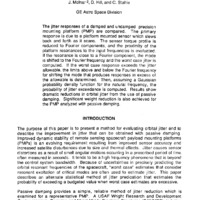-
Title
-
Statistical and Worst Case Evaluation of Orbital Jitter Reduction Using Passive Damping
-
Description
-
The jitter responses of a damped and undamped precision mounting platform (PMP) are compared. The primary response is due to a platform mounted sensor which slews back and forth as it scans. The sensor torque profile is reduced to Fourier components, and the proximity of the platform resonances to the input frequencies is evaluated. If the resonance is close to a Fourier component, the mode is shifted to the Fourier frequency and the worst case jitter is computed. If the worst case response exceeds the jitter allowable, the limits above and below the Fourier frequency for shifting the mode that produces responses in excess of the allowable is determined. Then, assuming a Gaussian probability density function for the natural frequency, the probability of jitter exceedance is computed. Results show dramatic reductions in orbital jitter from the use of passive damping. Significant weight reduction is also achieved for the PMP analyzed with passive damping.
-
Creator
-
Molnar, J.
-
Hill, D.
-
Stahle, C.
-
Publisher
-
Wright-Patterson Air Force Base, OH : Wright Laboratory, Flight Dynamics Directorate, Air Force Systems Command
-
Date
-
1991
-
Format
-
1 online resource (10 pages) : ill.
-
Type
-
article
-
Abstract
-
The jitter responses of a damped and undamped precision mounting platform (PMP) are compared. The primary response is due to a platform mounted sensor which slews back and forth as it scans. The sensor torque profile is reduced to Fourier components, and the proximity of the platform resonances to the input frequencies is evaluated. If the resonance is close to a Fourier component, the mode is shifted to the Fourier frequency and the worst case jitter is computed. If the worst case response exceeds the jitter allowable, the limits above and below the Fourier frequency for shifting the mode that produces responses in excess of the allowable is determined. Then, assuming a Gaussian probability density function for the natural frequency, the probability of jitter exceedance is computed. Results show dramatic reductions in orbital jitter from the use of passive damping. Significant weight reduction is also achieved for the PMP analyzed with passive damping.
-
Date Issued
-
1991-08
-
Extent
-
10
-
Corporate Author
-
GE Astro Space Division
-
Laboratory
-
Wright Laboratory
-
Report Number
-
WL-TR-91-3078 Volume II, pages EAA-1 to EAA-10
-
DoD Project
-
2401
-
DoD Task
-
240104
-
Distribution Conflict
-
No
-
Index Abstract
-
Contrails only
-
Photo Quality
-
Not Needed
-
Distribution Classification
-
1
-
Report Availability
-
Full text available
-
Provenance
-
University of Colorado Colorado Springs, Kraemer Family Library
-
Identifier
-
ADA241312
